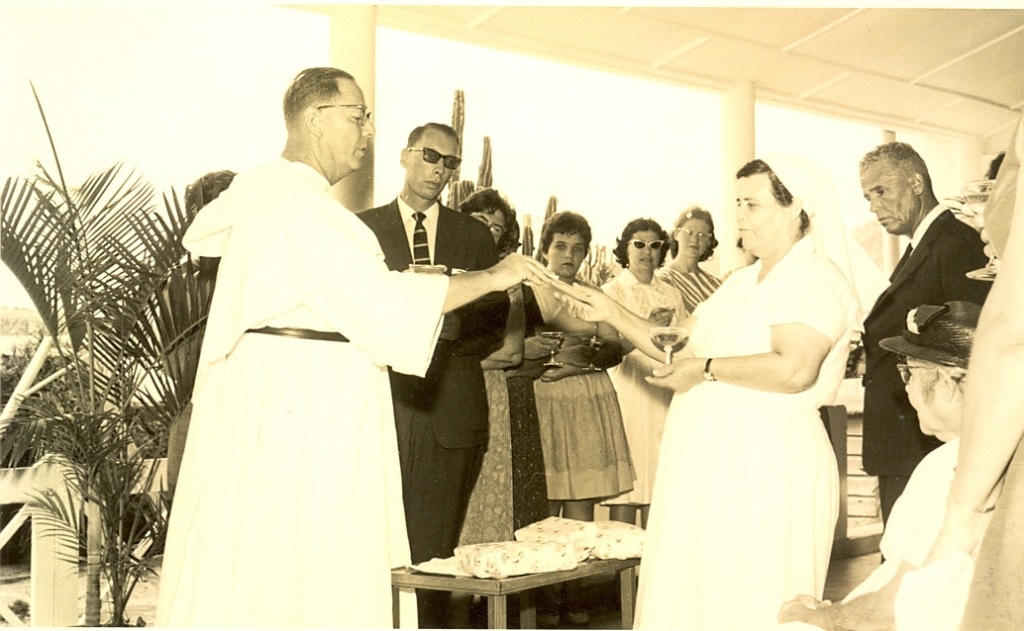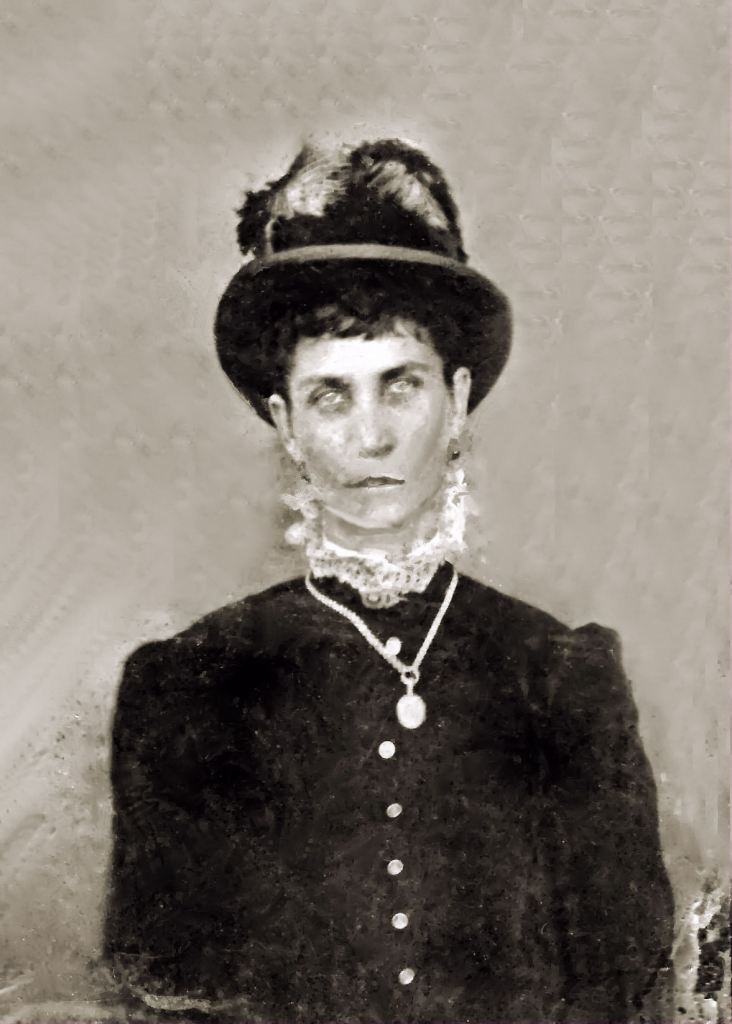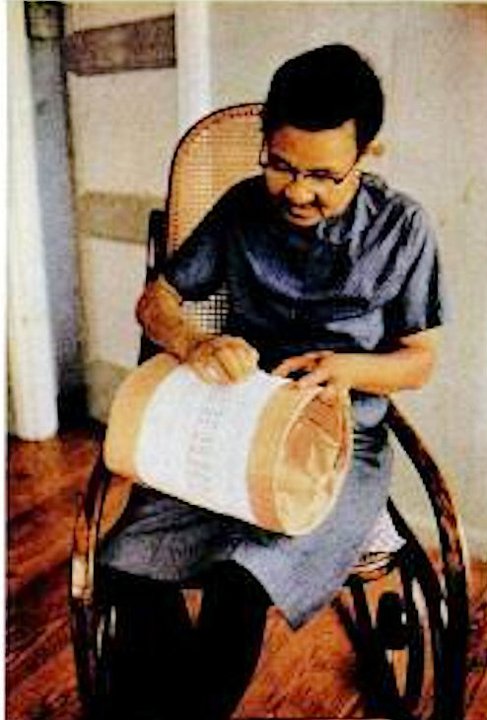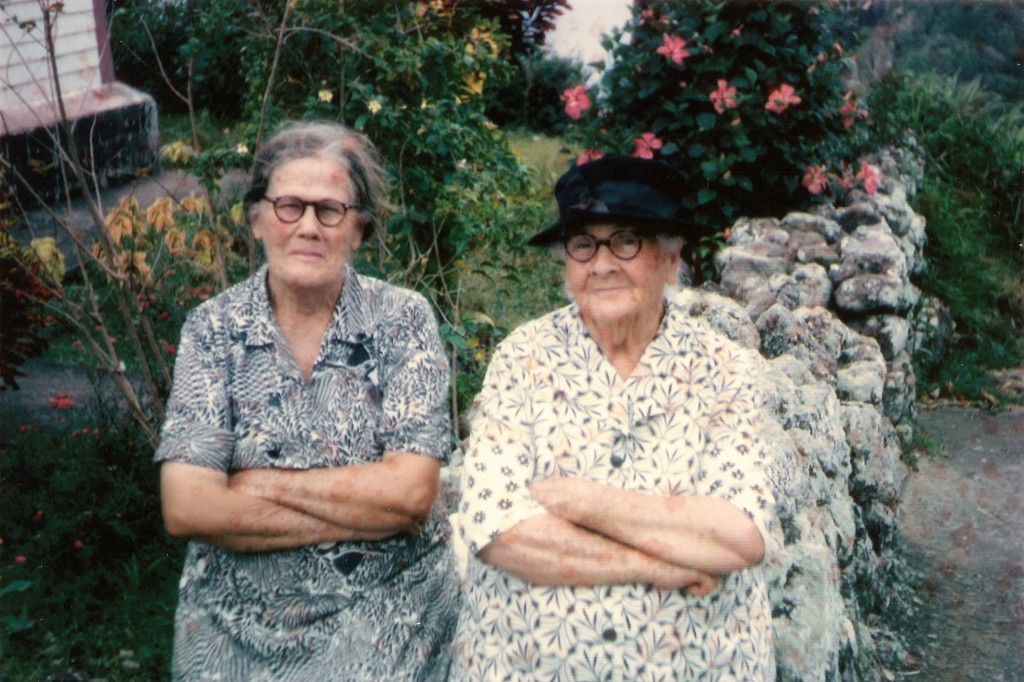The Local Midwives
In Dr. Robert Mol’s book “Doctor on Saba”, he has an extract from a letter written by Miss Esseline Douglas from Suriname who worked as a midwife on Saba from l942 to l945. Most of the doctors and professional midwives in the 20th century on Saba were from Surinam.
When she was an old lady Nurse Douglas returned to Saba and came to look me up at the office. According to her I was the last child delivered by a local midwife and she wanted to meet me. Given her description of conditions Nurse Douglas met on Saba when she started working here, she must have considered it a miracle that I had survived the delivery.

Too bad I was off island at the time. I would have enjoyed meeting her.
In her letter she writes:
” At that time there was an average of 25 to 30 deliveries per year. Most children were born in the period from September to December because most of the men came to the island around Christmas. The physicians had finally asked for professional obstetrical help, especially because of the high perinatal death rate.
The day after I arrived, an old crone came to introduce herself as the person who had done the work for years. When I asked her about her work, she showed me a small handbag, in which, in the middle of some prune tobacco, there was a small scissors, a few small pieces of naval string (most probably mine!), and a piece of cotton wool.
If a delivery took too long, the doctor was called, frequently too late. Those who could afford it would go to Puerto Rico or to St.Kitts at the point when they were due.
My care for pregnant women began shortly after I arrived and I did not find it difficult to get the women to come to my office hours. I visited those who lived too far away using a horse or a mule. Most deliveries were done at home. A number of women were admitted to the hospital, an old house in The Bottom, which also served as out-patient clinic. I did the puerperial care in the patient’s home. The perinatal death rate decreased considerably, and it was good to hear that the Minister had said in church that the area of the churchyard where unbaptized children were buried had not been used for years.
Several bimanual placental extractions and four breach births were carried out during this period. One interesting case which I must mention is about a woman who sold fish who was on her way to The Bottom. Along the way, she delivered the child. She put the baby and the placenta in a basket, put the basket on her head, and walked to the hospital in The Bottom.”
And so “Yeat” delivered me as the last of many children during her liftetime as a local midwife.
‘Yeat” was a survivor and had worked out her own survival strategy.
My parents home was in a village called “Behind-the-Ridge” above the old sulphur mine.
Back in the l9th century sulphur was like gold. No one had yet found out how to extract sulphur from crude petroleum. It was found around volcanoes. Several companies were formed in the U.S.A. and Barbados to dig for sulphur on Saba. The largest mines in the Eastern Caribbean are to be found on Saba and are now a tourist attraction.
My father tried to survive, first by going to Bermuda and working there for awhile. The second or third largest group of settlers on Bermuda were from Saba. My father and others returned to Saba to survive off the land during the great depression. He remained on Saba.
“Yeat” would move in to your home in the 8th month of pregnancy. She only left after the baby was a couple of weeks to a month old. According to my father if you had left it up to “Yeat” she would have remained until the baby decided to get married and have more babies for “Yeat” to deliver.
Officially there was no fee involved. Other than “Yeats” three squares a day ,
and she had a good appetite I am told. You had to lodge and feed her for at least six weeks. Where we lived gave her the perfect excuse as our house was quite a distance from hers.
The old time “local” doctors and “midwives” built up a certain mystique around themselves similar to the witch doctors of old. People were convinced that only certain people were gifted enough to do a delivery or set a broken bone. My great aunt Ann Elizabeth Johnson “Miss Shishi” was known for her ability to set a bone. If someone walked with a limp people would say “You can tell that “Miss Shishi” did not set that bone.”

“Kiby” Hassell, whose father was Dr. A. C.M. Lionarons who served on Saba from l904 to l907, says the following in Dr.Julia Crane’s book “Saba Silhouettes” about the local midwives. “Yeat” lived close to her house in English Quarter.
” It was midwives in them days (when I was born) and the midwives did good. There was one, she used to live over here too, to the house above. She used to have to go over to Mary’s Point, and that’s no fun. And she used to have to go over there. You don’t know where there is, Mary’s Point, ’cause that’s away back. And she went all around. She brought in most everybody here in Windwardside, and she never lost a case. Another one brought me, but not her. And she brought in nearly everybody. But the walks that she had to take, the long walks, from here to the Quarter, and all around. But she had to go, because there was no one to go but her.”

“Yeat’s” house surivived in fairly good condition until several years ago. In the early nineties a great nephew of hers, John Hassell of New York, came to Saba and he built some apartments there. He was an avid jogger and died with a heart attack before he could do more. It was his hope that the maternity ward at the hospital could be named in her honour.
There were other midwives as well.In doing research on something else I came across a number of names. There may have been more, but here are some of them.
Hannah Wilson, The Bottom, born l860.
Sophia Rock, The Bottom, born l871
Mary Hassell, St.John’s, born l860
Rosita Lynch-Hassell, English Quarter, born l873
Annie L. Pamenter-Simmons, The Bottom, born l894
Ruth Camille Smith born Dunkin, The Bottom, born June 2lst, l9l4.
Mrs. Elsie Peterson in “Saba Silhouettes” had the following to say about the midwives.
” They were both white, as well as black. They used to call them midwives then, that time, and that was all the doctor you had at that time. One was black. The first one that came to me; and she was good, yeah, she knew her business. Some was good and some wasn’t. One came to me, her name was Ann Mary. She was a white woman, and she lived on St.John’s; and she used to drink, you know. And she came to me, and she was half drunk with one of mine. But anyway she done her business. She knew what to do. I tell you what come right in them days come right; and what didn’t come right was all the same. You wouldn’t know what you had died with if you had been to die, nor nothin. No, they died and that was it. They didn’t know what they had died with. Midwives a long time ago wasn’t much. Anyway they done their business. They knew what to do, at least the ones that came to me. I had whole ten children you know.”

“You know who I trained as a midwife? Ruth Smith. She is a good midwife, you know, but she went through everything with me. When Dr. Tjong-Sie-Fat came here to work with us Ruth could take her own cases; we’d go to dances and leave Ruth with the cases. She knew her work. Anyway I trained Ruth, and we could leave her in charge. Lizzie took my place after I left. Bessie was there before I left. She used to work in the Windwardside, with the maternity nurses- with the midwife from Suriname. It was only if they had cases in the hospital in Windwardside for a long time, we would each one have to take turns, Laura Linzey and myself, to go over and help.
Midwifery was the most important part of my nursing. You see the beginning of life in this world and several times you see the ending of it. And that is the thing I like – to see the first breath a human takes in this life. Oh, it’s nice. You could say no two cases are exactly alike. That is what I like.”
The past thirty years, or so, most children from Saba have been delivered on St.Maarten.
For many reasons, with better facilities there, most women choose that option rather than taking chances here. Men are unaware of the hardships women have endured with deliveries here. I know from personal experience of a situation where the doctor was half-drunk (as Miss Elsie would say), delivering a child. The doors were wide open, his dogs walking in and out of the delivery room, and the lady going through the ordeal was not even from here. At that point “Yeat” with her old rusty scissors would have been a most welcome sight.
There are still a number of people who can brag that “Yeat” delivered them. These many years later I am proud to be able to say the same. And so ” Yeat” wherever you are, here’s to you girl.
Will Johnson
